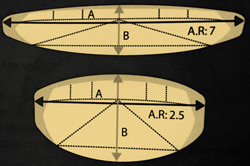Kitesurfing – what is it that is happening?
Even though physics weren’t your best subject in school you may have hear of aerodynamics, that is how the air affect an object in motion. It is because of the law of aerodynamics that we can kitesurf in the first place, through the lift that it creates. But how is this force created and how can we affect it? And what is the meaning of aspect ratio and angle of attack? Why is a thin profile faster than a thick profile, and what’s the point of having an arched canopy? Terms that your instructor perhaps explained to you during your kite course, but which your, at the moment already feverishly working braincells, couldn’t absorb. But do no despair, hand on for a quick lesson that perhaps won’t make you a btter kiter, but at least a little bit wiser 🙂
Why is the kite pulling?
The reason to why we can kitesurf is due to this invisble force that pulls the kite upwards/forward. How is this force created?
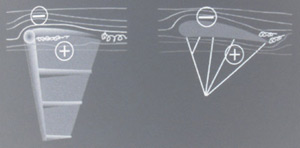 As the wind hits the kite, the air flow is being separated so that some air passes above the kite’s canopy (extrados) and some air passes below the kite’s canopy (intrados). Hence the two air currents that passes the kite take on path each. Due to the shape of the kite the speed of the upper air flow will be a big faster than the lower air flow. The air flow that passes under the kite, on the intrados side, will be slowed down which in turn increases the pressure. The comprehended pressure on the lower side will push the intrados away from it. The opposite happens on the upper side. Here the accelerating air speed creates a bigger space between the air atoms which reduced the pressure. In turn, this creates a suction force that pulls the extrados towards it.
As the wind hits the kite, the air flow is being separated so that some air passes above the kite’s canopy (extrados) and some air passes below the kite’s canopy (intrados). Hence the two air currents that passes the kite take on path each. Due to the shape of the kite the speed of the upper air flow will be a big faster than the lower air flow. The air flow that passes under the kite, on the intrados side, will be slowed down which in turn increases the pressure. The comprehended pressure on the lower side will push the intrados away from it. The opposite happens on the upper side. Here the accelerating air speed creates a bigger space between the air atoms which reduced the pressure. In turn, this creates a suction force that pulls the extrados towards it.
The two forces on the intrados and extrados work together to create the aerodynamical force exerted on the kite. Since the position of the kite always is perpendicular to the kite lines then the kite will pull against the lines. If the kite is positioned straight ahead of you in zenith then it will pull you upwards in a vertical direction. If the kite is positioned at the surface then it will pull you forward in a horizonal direction. In order to fly the kite must have a streamlined wing profile and it must be flewn in an effective angle between 15° to 25°.
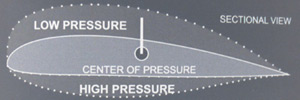 As the wind speed (S) increases over a profile, then the pressure (P) is reduced,(S+ = P-). The negative pressure exerted on the extrados makes the kite being sucked upwards.
As the wind speed (S) increases over a profile, then the pressure (P) is reduced,(S+ = P-). The negative pressure exerted on the extrados makes the kite being sucked upwards.
As the wind speed is reduced under a profile (S-), then the pressure increases (P+) which in turn pushes on the intrados. The force that push the kite upwards makes up about 25% of the total force exerted on the kite. The upwards suction force makes up 75% of the total force. Just like an airplane wing, a kite flies mainly thanks to the reduced pressure on its upper side.
The generated force depends on the angle between the kite and the wind. The image below shows how the air flow is depending on the angle between the kite and the wind (angle of attack). The bigger angle, the more turbulence.
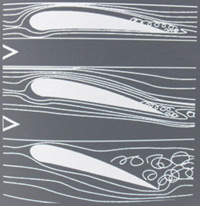


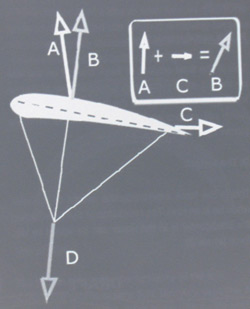 Some physical terms:
Some physical terms: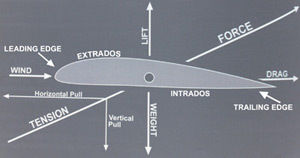
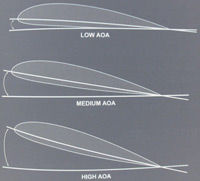
 The canopy shape
The canopy shape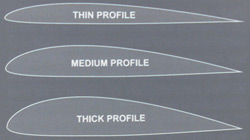 The profile
The profile
